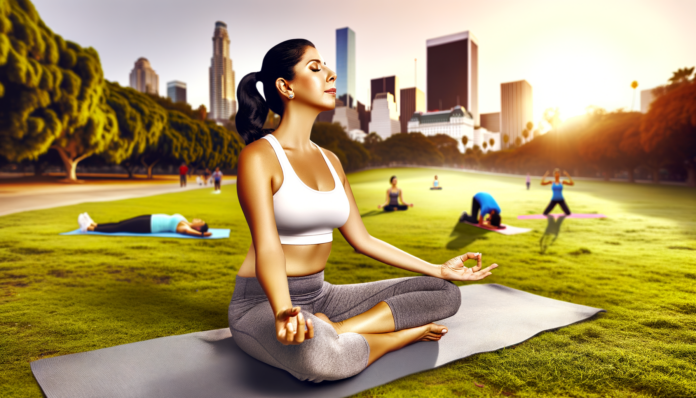Introduction to Mindfulness and Modern Living
Understanding Mindfulness
Mindfulness, derived from the Eastern concept of smriti, meaning “to come back to awareness,” is the practice of bringing one’s full attention to the present moment with an attitude of openness and curiosity. It is not confined to meditation; it extends to activities such as yoga, walking, eating, and even the simple choices of daily living. Mindfulness is about being fully engaged in the here and now, observing thoughts and sensations without judgment, and fostering a state of awareness that can transform ordinary experiences into extraordinary ones.
Challenges of the Modern Woman
The modern woman often faces a unique set of challenges, balancing professional aspirations with personal responsibilities, all while navigating the complexities of societal expectations. The relentless pace of life can lead to stress, disconnection, and a sense of being overwhelmed. Mindfulness offers a refuge, a way to slow down and reconnect with oneself amidst the chaos of everyday life.
The Importance of Integrating Mindfulness
Integrating mindfulness into daily life is essential for combating the stress and disconnection that come with modern living. It provides a tool for emotional regulation, stress reduction, and enhanced well-being. By cultivating mindfulness, women can develop resilience, improve focus and productivity, and nurture a sense of peace and balance.
Objective of the Article
The objective of this article is to empower the modern woman with practical mindfulness techniques that can be seamlessly integrated into her hectic life. We aim to provide a comprehensive understanding of mindfulness, its benefits, and how it can be applied to various aspects of daily living to foster a harmonious and fulfilling lifestyle.
The Science of Mindfulness
Mindfulness and the Brain
Recent neuroscientific research has illuminated how mindfulness practice can lead to significant changes in brain structure and function. Studies using functional magnetic resonance imaging (fMRI) have shown that mindfulness meditation can increase the density of gray matter in the prefrontal cortex, which is associated with higher-order brain functions such as awareness, concentration, and decision-making. Additionally, mindfulness has been linked to decreased activity in the amygdala, the brain region involved in processing emotions like fear and stress, suggesting a potential mechanism for its calming effects.
Stress Reduction and Emotional Regulation
Mindfulness is particularly effective in reducing stress and enhancing emotional regulation. By fostering an attitude of non-judgmental awareness, individuals can observe their thoughts and feelings without becoming overwhelmed by them. This detachment allows for a more measured response to stressful situations, rather than a reactive one. Techniques such as diaphragmatic breathing and body scanning can activate the body’s relaxation response, counteracting the fight-or-flight response that is often triggered by stress.
Mindfulness and Physical Health
- Immune System: Regular mindfulness practice has been shown to boost the immune system, helping the body to fend off illness.
- Heart Health: Mindfulness can lead to reductions in blood pressure and improvements in heart rate variability, both of which are good indicators of cardiovascular health.
- Chronic Pain: For those suffering from chronic pain, mindfulness can alter their perception of pain and improve their quality of life.
Long-Term Benefits for Well-being
The long-term benefits of mindfulness practice are profound. Sustained practice can lead to enduring changes in mood and levels of happiness. Mindfulness can also improve relationships by enhancing empathy and compassion, both towards oneself and others. Furthermore, the practice can foster a sense of connectedness to the present moment, which is often lost in the hustle and bustle of modern life. By integrating mindfulness into daily routines, individuals can cultivate a more balanced and fulfilling life.
In conclusion, the science of mindfulness offers a compelling case for its practice as a means to improve mental, emotional, and physical health. With its roots in ancient traditions and its wings in contemporary science, mindfulness stands as a testament to the human capacity for transformation and resilience.
Practical Mindfulness Techniques
Breathing Exercises
Mindfulness begins with the breath. Breathing exercises are a simple yet powerful way to bring your attention back to the present. Start by finding a quiet space, sitting comfortably, and focusing on your breath. Inhale deeply for a count of four, hold for four, and exhale for four. This technique, known as square breathing, can be practiced anytime to calm the mind and reduce stress.
Mindful Movement and Yoga
Mindful movement and yoga combine physical postures with breath awareness to enhance mindfulness. Even a short session can increase body awareness and reduce tension. Online platforms offer guided yoga sequences that can fit into a busy schedule. As you move through each pose, maintain a focus on your breath and the sensations in your body, cultivating a deeper connection between mind and body.
Guided Meditation
For those new to mindfulness, guided meditations can provide a helpful structure. These sessions, led by an instructor, can be accessed through apps or online resources. They often include instructions on breath control, visualization, or body awareness. Guided meditations can vary in length, making them a flexible option to fit into any part of your day.
Body Scans
A body scan is a technique where you mentally sweep through your body, bringing awareness to each part. Start at the toes and move upwards, noticing any tension or discomfort without judgment. This practice not only promotes relaxation but also enhances bodily awareness and helps in recognizing the mind-body connection.
Mindful Eating
Mindful eating is about engaging all senses to fully experience your meal. Begin by observing the colors and shapes on your plate. Chew slowly, savoring the flavors and textures. By eating mindfully, you can improve digestion, regulate appetite, and transform a daily routine into a moment of mindfulness. It’s also an opportunity to practice gratitude for the nourishment provided.
Integrating these practical mindfulness techniques into your daily life can help you find peace in the midst of a hectic schedule. Whether it’s a few minutes of deep breathing or a yoga session, each practice offers a step towards a more mindful and balanced life.
Incorporating Mindfulness into Daily Routines
Creating Mindful Mornings
Starting your day with intention can set a positive tone for the hours ahead. Begin by waking up a few minutes earlier than usual to avoid the rush. Use this time to engage in a short breathing exercise, setting intentions for the day, or practicing gratitude. As you sip your morning beverage, do so mindfully, savoring the taste and warmth, and acknowledging the moment of calm before the day unfolds.
Mindfulness at Work
The workplace can be a hub of stress and distraction, but it also presents an opportunity for mindfulness. During your workday, take short mindful breaks to refocus and recharge. This could be a moment of deep breathing, a brief meditation, or simply stepping away from your desk to stretch and observe your surroundings. Integrate mindfulness into tasks by giving your full attention to one activity at a time, thereby enhancing productivity and reducing errors.
Mindful Commuting
Commuting can be a source of frustration, but it can also be a perfect time to practice mindfulness. If you’re driving, focus on the sensation of the steering wheel in your hands and the route you’re taking. If you’re using public transport, listen to a guided meditation or simply observe the world passing by without judgment. This practice can transform travel time into a period of transition, allowing you to arrive at your destination more centered and calm.
Evening Wind-Down Rituals
Evenings are your chance to decompress and prepare for restful sleep. Establish a wind-down ritual that may include gentle yoga, reading, or a body scan meditation to relax each part of your body. Dim the lights and disconnect from electronic devices at least an hour before bed to signal to your brain that it’s time to wind down. Reflect on the day with a sense of non-attachment, acknowledging what went well and releasing any tensions.
By weaving mindfulness into the fabric of your daily life, you create a resilient foundation for dealing with the complexities of modern living. These practices are not time-consuming but rather, are about being present and intentional with the time you have. Embrace each moment, and watch as mindfulness becomes not just a practice, but a cherished part of your everyday routine.
Overcoming Common Obstacles
Time Constraints
One of the most significant barriers to practicing mindfulness is the perception of not having enough time. Modern women often feel there are not enough hours in the day to juggle work, family, and self-care. However, mindfulness doesn’t require hours of meditation; it can be woven into the fabric of daily life. Start with just a few minutes each day, perhaps upon waking or before bed, to practice deep breathing or express gratitude. These small moments can have a profound impact on your well-being.
Distractions and Multi-Tasking
In a world where multitasking is often celebrated, it can be challenging to focus on the present moment. Distractions, whether from our devices or our to-do lists, can make mindfulness seem like an unattainable task. To combat this, create mindful moments throughout your day. This could be while drinking your morning coffee, taking a shower, or waiting in line. Use these opportunities to ground yourself in the now, focusing on your senses and the task at hand.
Maintaining Consistency
Consistency is key to reaping the benefits of mindfulness, but it can be difficult to maintain a regular practice. To help, set reminders on your phone or leave sticky notes in places you’ll see them. Treat your mindfulness practice like any other important appointment by scheduling it into your day. Remember, consistency doesn’t mean perfection; it’s about committing to return to your practice, even after missed days.
Dealing with Skepticism
Mindfulness might be met with skepticism, both from within and from others who may not understand its value. If you encounter doubt, arm yourself with knowledge. Learn about the science behind mindfulness and its benefits for mental and physical health. Share your experiences and how the practice has positively impacted your life. Most importantly, remember that your mindfulness journey is personal, and its worth doesn’t depend on external validation.
Mindfulness for Physical Health and Appearance
Mindfulness and Weight Management
Integrating mindfulness into weight management strategies can lead to more sustainable and healthy lifestyle changes. Mindful eating practices encourage individuals to slow down and pay attention to the sensory experience of eating, which can help in recognizing satiety cues and reducing overeating. By focusing on the present moment, one can also become more aware of emotional triggers that lead to unhealthy eating habits, such as stress or boredom. Mindfulness can thus be a tool for developing a healthier relationship with food and body image.
Mindfulness for Skin Care and Aging
Mindfulness can also play a role in skin care and the aging process. Stress is known to exacerbate skin conditions and accelerate aging. Mindful practices that reduce stress can therefore contribute to healthier skin. Additionally, mindfulness encourages a non-judgmental acceptance of oneself, which can foster a more positive body image and acceptance of the natural aging process. By being present and caring for the skin without harsh judgment, one can adopt a skincare routine that is both nurturing and effective.
Mindful Exercise
Exercise is not only about physical health but also about mental well-being. Mindful exercise involves being fully present during physical activity, paying attention to the body’s movements, and breathing with intention. This approach can transform routine workouts into a meditative experience, increasing the enjoyment of exercise and reducing the risk of injury by promoting greater body awareness. Whether it’s yoga, walking, or weight training, mindful exercise enhances the connection between mind and body.
Integrating Mindfulness with Diet and Nutrition
Finally, mindfulness can be integrated into diet and nutrition by consciously choosing foods that nourish the body and mind. This involves being aware of the origins of food, its nutritional content, and how it affects one’s well-being. Mindful eating practices encourage savoring each bite and appreciating the flavors, textures, and aromas, which can lead to more satisfying meals and a balanced diet. By making mindful choices, one can align their eating habits with their physical health goals and ethical values.
In conclusion, mindfulness offers a holistic approach to managing weight, caring for the skin, exercising, and eating healthily. By fostering a mindful connection with our bodies, we can enhance our physical health and appearance, leading to a more balanced and fulfilling life.
Conclusion: Embracing Mindfulness as a Lifestyle
The Journey of Mindfulness
Mindfulness is not a destination but a continuous path that unfolds with each breath and mindful moment. It’s a journey that invites us to explore the depths of our inner world, to embrace the present with all its imperfections, and to cultivate a sense of peace amidst life’s inevitable chaos. As modern women, we often strive for perfection and control, but mindfulness teaches us the beauty of letting go and the strength found in vulnerability. It’s about learning to dance in the rain rather than waiting for the storm to pass.
Building a Supportive Community
While mindfulness is a deeply personal practice, the support of a like-minded community can be invaluable. Sharing experiences, insights, and challenges with others on a similar path can provide encouragement, perspective, and a sense of belonging. Whether it’s through local meditation groups, online forums, or simply a circle of friends, building a community fosters a nurturing environment where growth and healing can flourish. Together, we can celebrate our successes, navigate our struggles, and remind each other of the importance of staying present.
Continual Learning and Practice
The essence of mindfulness lies in its practice. It’s an ongoing process of learning, unlearning, and relearning. As we integrate mindfulness into our daily lives, we discover layers of our consciousness and uncover new ways to respond to our experiences. Books, workshops, retreats, and even digital apps can serve as resources to deepen our understanding and commitment. However, the true teacher is the practice itself—each mindful breath, each moment of stillness, each step taken with intention.
The Path Forward
As we look to the future, let us do so with the wisdom of mindfulness lighting our way. The path forward is not about adding more to our already full plates but about finding space within our days to breathe, to be, and to connect with our true selves. It’s about setting boundaries that honor our well-being, embracing self-compassion, and recognizing that self-care is not selfish but essential. With each mindful choice, we pave the way for a life lived with authenticity, balance, and peace.
In embracing mindfulness as a lifestyle, we acknowledge that the journey is unique for each of us. Yet, the destination is the same—a life lived with awareness, compassion, and a deep connection to the present moment. Let us step forward with open hearts and minds, ready to experience the richness of life, one mindful moment at a time.








